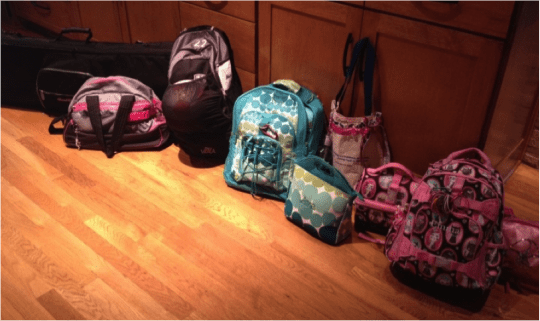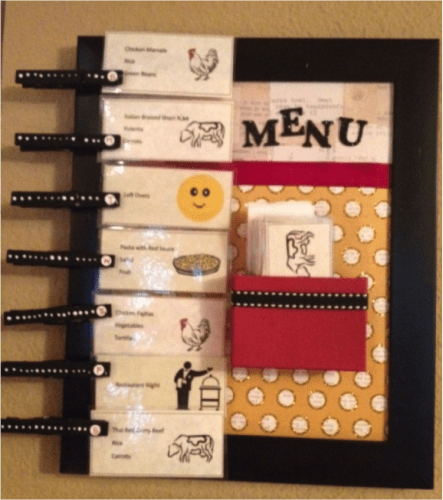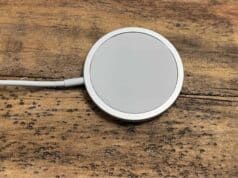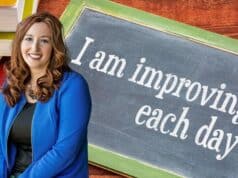Mark's Note: Today's guest post is from a colleague I have worked with before on a hospital project. Bernita and I worked together at a children's hospital, as she wrote about here on the HKS blog. Bernita's post is modified from something she originally shared internally at HKS… the topic of “Lean and Kaizen at home” is something that's near and dear to my heart (see my previous posts on “Everyday Lean” and Chapter 12 of our book Healthcare Kaizen).
 In my role at HKS, a leading architectural firm, I am involved with projects that involve Lean process improvement in hospitals and health systems.
In my role at HKS, a leading architectural firm, I am involved with projects that involve Lean process improvement in hospitals and health systems.
My household would crumble without systematic implementation of Lean strategies. 5S (sort, set in order, shine, standardize, sustain) is one such strategy.
Between my two children, there are nine extra- or after-school activities that they participate in. And I know that this will only get worse. Every activity has gear associated with it. We have implemented 5S for each activity.
Every activity has a custom bag (sort, set in order) with a standardized “Par Level.” If an item gets used, it is washed and replaced (shine, standardize, sustain). They take responsibility for this, as it is their activity. On the morning of the activity, they simply need to grab the bag, as everything is there. We also have a few outdoor activity bags that hang by the door that contain sunscreen, Band-Aids, Neosporin, wet wipes, antibacterial gel, and bug spray for soccer games or trips to the playground. We don't waste time thinking about what we need, because it is already ready and done. In nine years, I can honestly say we have never had to do the “where are my ballet shoes?” scramble.
The past two years, I have traveled about 50% of my time. I spend an average of three to four days away every two weeks. There was a period of time when Chick-fil-a saw my children as much as I did. We also have a nanny three days a week who feeds the kids, but I do not expect her to cook for them. Implementing Lean in our household has helped facilitate home-cooked meals and improved eating habits.
I have menu cards written with about 50 meals that everyone will eat. On weekends, my kids pick meals for the week based on travel, activities, and interest. All recipes are contained in a log where the ingredients needed are pulled to a list and purchased. (You would not need to do this recipe board unless you have a sick twisted addiction to Pinterest and have a laminator) As a result, our refrigerator only contains what we need for a week, and the pantry is the same. Standard work means it is cleaned when items are put away. My freezer is now free of all convenience foods, leaving room for more important things, like coffee and vodka. My kids don't ask about what is for dinner, because they know and they picked it. We buy less food, healthier food, and we throw less away. Everybody wins. Especially Pinterest, Pinterest always wins.
I could talk about the laundry system, pantry system, toy system and the closet system, but it is important to keep all the crazy contained and only share a little at a time. It works though…I have even caught my nine-year-old daughter creating Standard Work Instructions for her five-year-old sister… and she liked it.
Is there any waste in your current household processes? Write the steps down, and see what you could do to fix them. You can avoid some of the crazy mornings and have more pleasant times with your kids… and Pinterest.
Update: This post was a recipient of a “best of” award by the LeanSelf.org blog:
About Bernita Beikmann, AIA: Bernita is a healthcare architect and the Director of Lean Strategy for the Healthcare Practice at HKS Architects. She has worked with many healthcare systems combining their operational improvement efforts with the design of new facilities. She also works with project teams to facilitate lean within the design and construction process.
What do you think? Please scroll down (or click) to post a comment. Or please share the post with your thoughts on LinkedIn – and follow me or connect with me there.
Did you like this post? Make sure you don't miss a post or podcast — Subscribe to get notified about posts via email daily or weekly.
Check out my latest book, The Mistakes That Make Us: Cultivating a Culture of Learning and Innovation:













We also try to practice lean at home – first step has been to reduce “stuff” in the house. The trimming technique and 5-whys really helped us scale down a lot including some activities that our daughter was doing. BTW, doesn’t refrigerator and freezers encourage “inventory” ? We try to do a just-in-time way of cooking fresh food as much as possible reducing the use of refrigerator and compost the food waste at home to be used in our garden. And hopefully one day can get rid of the fridge(we got rid of the TV more than a year ago – internet is sufficient for us). But we still have washing machine and a dryer(that was a very poor call) that we need to get rid of. We also installed a white board to improve communication between people at home and do math and other stuff with our daughter. Important things are on the white board so that we don’t forget it.
I understand you have a different perspective of lean though. One question though – isn’t the factory model lean a bit boring for the children and wouldn’t that limit their creativity ?
Thanks for the comment, Jayadeep, and for sharing your comments.
I don’t think it’s accurate to call Lean a “factory model.”
Bernita works in a very creative field – architecture. I’ll let her comment, but I’m sure she encourage creativity.
Architecture and construction, it seems, require both process discipline AND creativity. Both can co-exist.
It’s often said (and I’ve seen this in healthcare), that having some structure and process can free up time to be more creative and to free up time for fun and games. Time not spent searching for soccer shoes means more time playing soccer, right?
You need to apply lean methodologies at the high level first, not just to elements of your system(eg: washing). As you very well know, itt is not just a process improvement methodology, it is far beyond that. So I am a bit uncomfortable when people apply the lean principles to just some elements of your system, which is apparently the author is trying to do at home. That would be a sub-optimal thing which doesn’t impact the whole part. So you need to have some overarching goals for the family like “reduce the stuff” or “lead a minimal life” where all other processes would help you achieve that. I don’t see any such goals here, but just application of lean methods(which isn’t a bad thing). But to me that is missing the lean thinking.
I’m not uncomfortable with it because Bernita says it makes her life and her family’s lives better. What could be more high-level or important than that?
Lean might be a “philosophy” but it’s designed to be applied in a business – to achieve long-term business results.
If there’s any piece of it that can be applied at home, I could consider that to be a bonus and nothing to criticize.
Would you use “strategy deployment” at home? Would you consider your children to be customers? While I think Lean methods can be helpful at home, I don’t think the whole business methodology translates.
Mark:
I would agree with you on the creativity portion. A home environment characterized by frenzy and firefighting leaves little time or energy for creativity, just like a production environment characterized by chaos and consternation leaves almost no time for thoughtful, ongoing improvement.
In fact, the more Lean the environment gets–the more processes improve and are standardized–the more time becomes available for activities that are satisfying and creative (if that’s what satisfies). This beats hassle and firefighting any day of the week.
BTW, if you wanted to learn about the lean way of child rearing, please read “Unconditional Parenting” by Alfie Kohn, http://www.unconditionalparenting.com/UP/
I’m a big fan of Alfie Kohn, but what makes his work “Lean”?
Here is my podcast episode with him, by the way:
LINK
Some additional discussion from LinkedIn and a comment from Bernita:
Erik van Luxzenburg: It seems effective, though, all thos bags against the wall, doesn’t make the house look uncluttered does it?
Bernita Beikmann: The bags only go there in the morning- on off days (when the child does not have that particular activity) she has the bag tucked in her closet in her room. Every day bags (lunch and school) are in a general area- but still tucked away. Saturdays are when they are restocked/ cleaned. Some see it as madness- but it works well.
Bernita, Mark,
I’m happy you are sharing this. For more than two years now I’m exploring the potential of lean at home. When I started, I did not find that many resources on the web about the idea. I think it is just growing recently and this as an interesting development.
Personally I call it Lean Self instead of lean at home, because I like a more holistic view upon it. With the basic idea to apply lean to all aspects of life.
It has been an interesting journey since I started it and I can only encourage everybody to travel that road. Last year I even started a blog about Lean Self, which for example covers 5S, too (What is Lean Housekeeping (with 5S)?).
The question “creativity vs. lean” interests me very much, too. There is a danger that if you over-organize your life, you start to acquire character traits that stiffle creativity. I think the best recipe is to explicitly search for the value creative activities give oneself. And to use the time saved by waste reduction to explore them.
Regards,
Jens
[…] parts of a new patient tower. You can read a bit about that work here. You might also remember her guest post on the blog from 2013. I hope you enjoy our […]